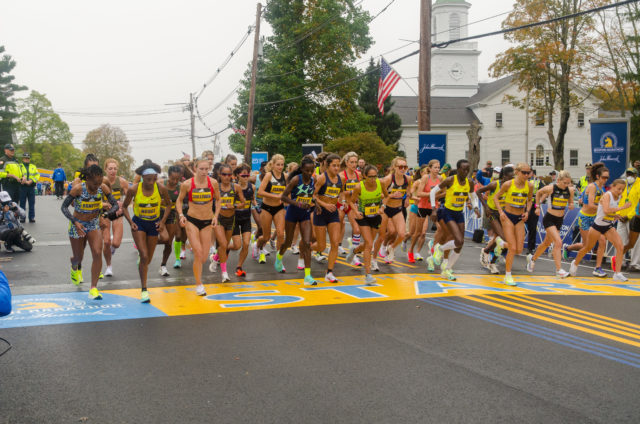The iconic American race returns, for the first time ever in the fall
By Leah Etling
It was a Boston Marathon to remember.
The first edition of the race to ever be held in the fall, the 125th Boston Marathon marked the race’s triumphant return after two missed April iterations due to the pandemic.
We chatted with Lauren Proshan, director of operations for the Boston Athletic Association (B.A.A.), to get her perspective on how the race went and what’s in store for the 126th Boston Marathon, set for Monday, April 18, moving back to its traditional Patriots Day timeline.
“I wish I had a better word than awesome, but just to see everyone’s sheer excitement and relief to be back on the roads was truly awesome,” said Proshan, still smiling at the memory. “The city as a whole felt completely alive. And not to mention, there was a Red Sox playoff game that evening. So, there was just this very cool feeling of excitement throughout the whole day.”
Runners expressed it in droves.
“We passed Wellesley (College) with the famous screaming tunnel which was super cool and they were all screaming with some very interesting signs they were holding,” said Harris Craycraft, a marathon finisher and YouTube blogger who made a video about his experience. “This was the point where they would normally kiss runners, but they couldn’t do that because of COVID, and that was OK.”
Runners’ acceptance of the changes necessary to adapt to pandemic-era racing conditions was an invaluable factor for every event, large or small, that went on this fall. And in Boston’s case, the change to a rolling start in Hopkinton was so popular that the race is now under pressure to keep it. Runners didn’t have to wait for long periods in their pre-assigned corrals, they simply got off the transport buses, made their way to the start line and were able to begin their race.
Veteran running journalist Amby Burfoot put it this way: “No wait time in a chilly, uncomfortable Athletes’ Village? What’s not to like? In an online poll at Boston Buddies, a Facebook group, fully 90 percent of over 500 respondents said they’d like to see the rolling start become a fixture in future Boston Marathons.” (Read the article here.)
We asked Proshan about the rolling start and runners’ affection for it. She noted: “What a lot of folks may not know is that we had to request an additional hour of time on the road to make this happen. We do run through eight city and town jurisdictions, and that means getting permission from eight cities and towns to have their roads closed for an hour longer.”
But that being said “we’re already talking about whether there is a hybrid model? Is there a different way to reduce that time in the Athletes’ Village or just waiting at the start area in general? Nothing’s off the table, and we certainly heard loud and clear what people like.”
In addition to the innovative start, 2021 provided an opportunity for the B.A.A. to revamp its finish line setup and credentialing system.
“With partner John Hancock’s blessing, we took that program in house and revamped what it meant to be wearing a credential at the event,” explained Proshan. “We simplified the system by simplifying our boundaries, and by default made the event much more simple and secure.” The change helped enhance social distancing in the finish line area.
The finish line renovation, constructed from “the world’s coolest building blocks and Lego-style construction system,” as described by Proshan, also involved removing the spectator bleachers that have long been a Boston fixture. In past years, more than 3,000 people would typically cram in to watch the emotion and elation as runners crossed one of the world’s most coveted finish lines.
“It provided a much cleaner, spectator-friendly area. It’s one of those things we will be having long discussions about going forward. But because of the pandemic, we were able to see something in a different way that we had never done before. We will bring back a version of it, but it has forced us into reimagining what that will look like.”
On Nov. 2, the BAA announced that the field size for the April 2022 Boston Marathon will be 30,000 and all accepted runners must be fully vaccinated to participate. With a timeline of less than six months to produce one of the most historic races on earth, Proshan and her team are already off and running.

